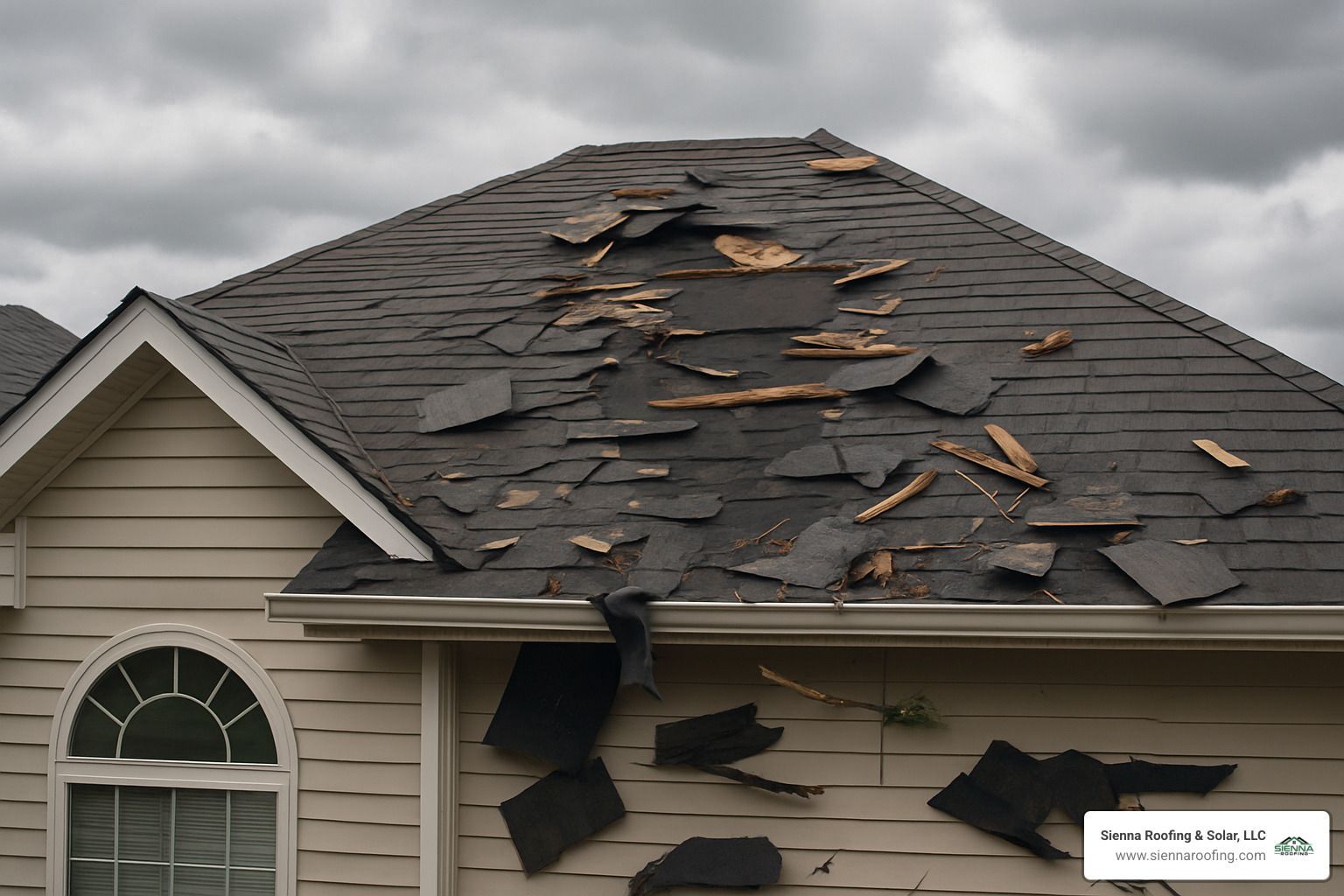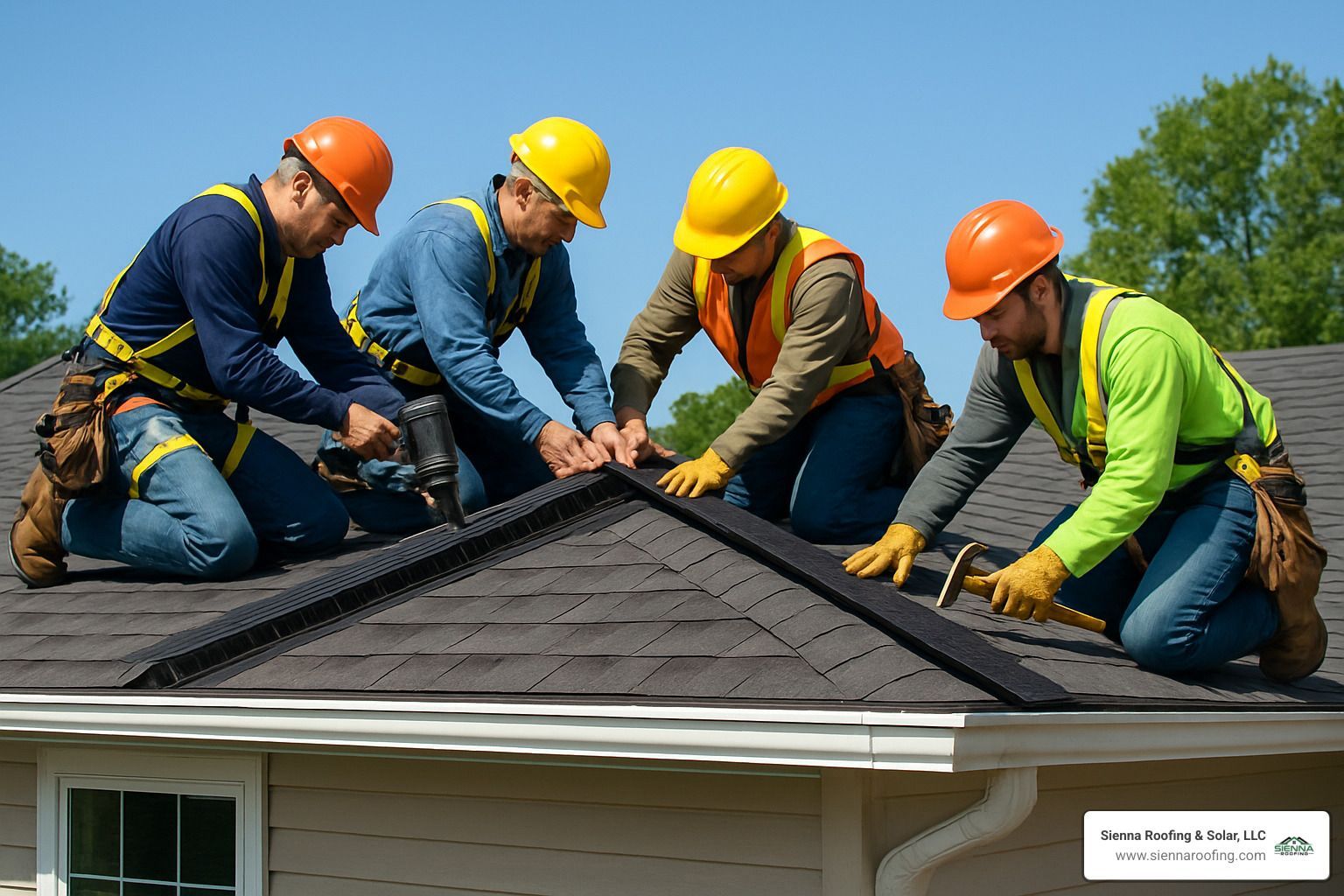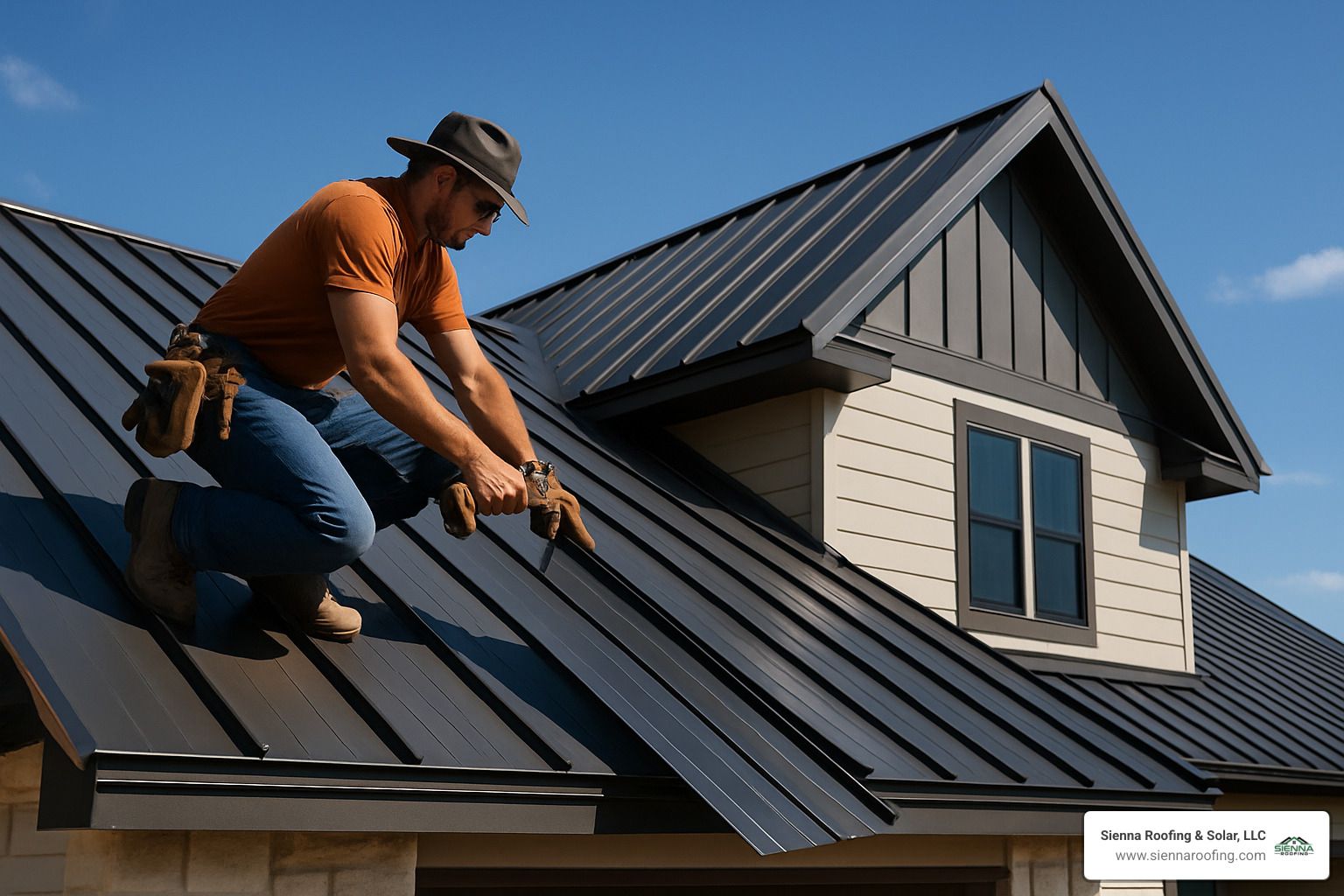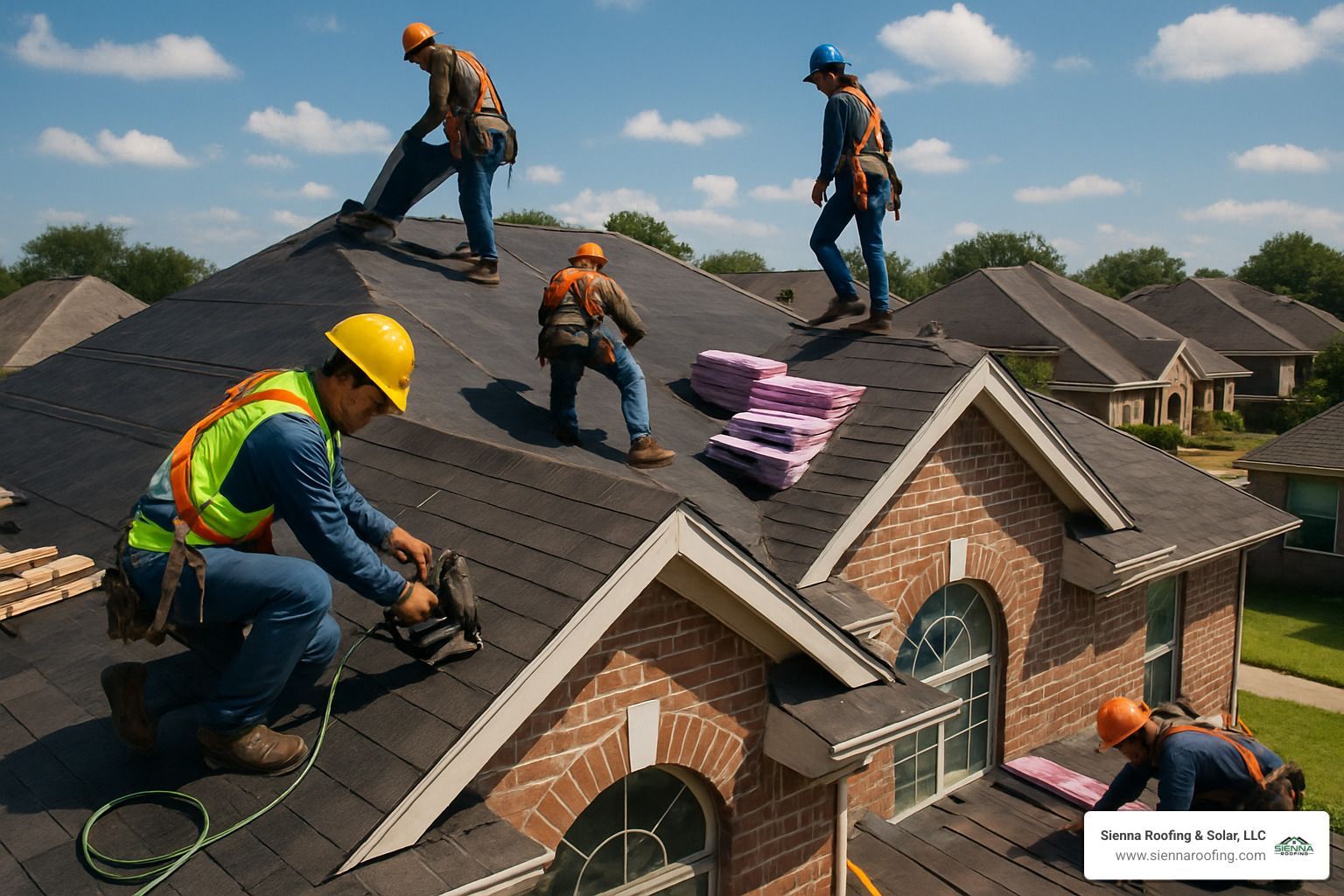Don't Get Shingled Out—Your Guide to Damaged Roof Shingles

Andre Castro
Owner of Sienna Roofing
Why Damaged Roof Shingles Put Your Home at Risk
Damaged roof shingles are more than just an eyesore - they're your home's cry for help. When shingles fail, they expose your entire roofing system to water damage, structural problems, and costly repairs that can average $3,750 for water damage restoration alone.
Quick Answer: Common signs of damaged roof shingles include:
- Missing or loose shingles blown off by wind
- Curling or cracking from age and weather exposure
- Granule loss creating bald spots on shingles
- Dark streaks indicating algae or moisture problems
- Blistering or peeling paint around roof edges
- Water stains on ceilings or walls inside your home
Here in Sugar Land and the greater Houston area, our intense summer heat, sudden hailstorms, and hurricane-force winds create the perfect storm for shingle damage. With wind speeds of just 50-60 mph capable of compromising shingle integrity, Texas homeowners face constant threats to their roof's first line of defense.
The good news? Most shingle problems start small and give you warning signs before they become major headaches. Catching damage early can mean the difference between a $100-500 DIY repair and a $9,100 full roof replacement.
I'm Andre Castro, CEO and founder of Sienna Roofing & Solar, and I've spent over five years helping Houston-area homeowners identify and repair damaged roof shingles before they turn into costly disasters. My hands-on approach to every project has taught me that understanding the warning signs is your best defense against expensive surprises.

Spotting Damaged Roof Shingles Early
Your roof is only as good as the shingles protecting it, and recognizing damage early can save you thousands. We recommend conducting visual inspections twice a year - once in spring and once in fall - plus after any major weather events that hit our Houston area.
The key is knowing what to look for and where to look safely. Many homeowners miss critical damage because they don't know the subtle warning signs that precede major failures.
Common Signs of Damaged Roof Shingles
Damaged roof shingles manifest in several distinct ways, and each type of damage tells a story about what's happening to your roof system:
Curling and Buckling Shingles: When shingle edges curl upward or the middle section buckles, it's often due to poor attic ventilation or age-related deterioration. These lifted areas create entry points for wind and water.
Cracked Shingles: Temperature fluctuations cause thermal cycling - the constant expansion and contraction that eventually cracks shingles. In Houston's climate, this process accelerates due to our extreme heat followed by sudden cooling from thunderstorms.
Granule Loss: Those small, sand-like particles protect shingles from UV rays. Excessive granule accumulation in gutters signals that your shingles are losing their protective coating and aging rapidly.
Missing Shingles: The most obvious sign of damage, missing shingles leave your roof deck and underlayment exposed to the elements. Even one missing shingle can lead to water intrusion and structural damage.
Dark Streaks and Stains: While often mistaken for dirt, dark streaks usually indicate algae or lichen growth. Though not immediately damaging, these organisms can accelerate shingle deterioration by trapping moisture.
Blistering: Shingle blisters appear as raised bubbles on the surface and indicate moisture trapped within the shingle layers. When blisters break open, they expose the underlying material to weather damage.
Lifted or Loose Edges: Shingles with edges that lift or flap in the wind have lost their adhesive seal. This commonly occurs around the 10-15 year mark and creates vulnerability to wind uplift.
Our Shingle Roof services have shown us that homeowners who catch these signs early typically spend 70% less on repairs than those who wait until damage becomes severe.
Safe DIY Roof Inspection Checklist for Damaged Roof Shingles
Safety comes first when inspecting for damaged roof shingles. We never recommend homeowners climb onto their roofs - there are safer ways to assess your shingle condition.
Ground-Level Inspection:
- Use binoculars to examine shingles from the ground
- Look for obvious missing shingles or sagging areas
- Check for granules in gutters and downspouts
- Inspect the roof edge and eaves for damaged or loose shingles
- Examine flashing around chimneys, vents, and skylights

Attic Inspection:
- Look for daylight coming through the roof deck
- Check for water stains on rafters or decking
- Feel for soft or spongy areas in the roof deck
- Look for dark spots that indicate moisture intrusion
Interior Signs:
- Water stains on ceilings or walls
- Peeling paint around roof lines
- Unexplained increases in energy bills
- Musty odors that could indicate mold growth
Safety Protocol:
- Never inspect during wet, icy, or windy conditions
- Use a sturdy ladder with a spotter
- Maintain three points of contact when climbing
- Stay away from power lines
- Consider professional inspection for steep or complex roofs
Our Roof Maintenance program includes comprehensive safety protocols that protect both our technicians and homeowners during inspections.
What Causes Shingle Damage & How to Prevent It
Understanding what damages shingles helps you take proactive steps to protect your investment. In Texas, we face unique challenges that accelerate shingle deterioration compared to other regions.
Weather & Environmental Factors
Wind Damage: Wind speeds of 50-60 mph can start compromising shingle integrity. Houston's thunderstorms and occasional hurricanes create wind conditions that lift shingle edges, break the seal, and sometimes tear shingles completely off the roof.
Hail Impact: Texas leads the nation in hail damage claims. Even small hail can create pockmarks that weaken shingles, while larger hail stones can crack or puncture them entirely.
UV Radiation: Our intense Texas sun breaks down the asphalt compounds in shingles. The granules that protect against UV rays gradually wear away, leaving the underlying material vulnerable to cracking and deterioration.
Thermal Cycling: Daily temperature swings of 30-40 degrees cause shingles to expand and contract repeatedly. This constant movement eventually leads to cracking and loosening of the shingle structure.
Humidity and Moisture: Houston's high humidity creates conditions favorable for algae and moss growth. While not immediately damaging, these organisms can trap moisture and accelerate shingle breakdown.
Material & Installation Issues
Shingle Quality: Not all asphalt shingles are created equal. Lower-grade shingles may save money upfront but typically fail sooner under Texas weather conditions.
Improper Installation: Incorrectly placed nails, inadequate sealant, or improper shingle alignment can create weak points that fail prematurely. Each shingle should be secured with four nails, with an additional four nails from the overlapping course above.
Flashing Failures: Metal flashing around roof penetrations must be properly sealed and maintained. When flashing fails, water can penetrate behind shingles and cause damage that's not immediately visible.
Ventilation Problems: Poor attic ventilation causes heat buildup that can reach 150+ degrees, literally cooking shingles from below. Proper ventilation extends shingle life significantly.
Prevention Playbook
Regular Tree Maintenance: Trim branches that hang over your roof. Falling branches cause obvious damage, but even rubbing branches can wear away granules and create weak spots.
Gutter Cleaning: Clogged gutters cause water backup that can damage shingle edges and create ice dams in winter. Clean gutters twice yearly and ensure proper drainage.
Attic Ventilation: Ensure adequate intake and exhaust ventilation in your attic. This prevents heat buildup that accelerates shingle aging and reduces energy costs.
Professional Inspections: Schedule annual inspections with qualified roofers who can spot problems before they become emergencies. Our experience shows that preventive maintenance costs about 10% of emergency repairs.
Upgrade Considerations: When replacement time comes, consider wind-resistant shingles rated for higher wind speeds. These premium shingles often qualify for insurance discounts that offset their higher cost.
Our Asphalt Shingles installations include proper ventilation design and premium materials that withstand Texas weather conditions better than standard options.

Repair vs. Replace: Your Action Plan
Deciding between repair and replacement depends on several factors: the extent of damage, age of your roof, and long-term cost considerations. Here's how we help homeowners make this critical decision.
Repair When:
- Damage affects less than 30% of the roof
- Shingles are less than 15 years old
- Only a few shingles are missing or damaged
- Roof deck and underlayment remain sound
- No signs of structural damage
Replace When:
- Roof is over 20 years old with widespread damage
- Multiple leaks or extensive water damage
- Shingle granule loss is widespread
- Roof deck shows signs of sagging or rot
- Energy bills have increased significantly
The 20-year rule serves as a good guideline: if your roof is approaching or exceeding 20 years and showing multiple signs of damage, replacement often proves more cost-effective than extensive repairs.
DIY Fixes for Minor Shingle Damage
For homeowners comfortable with basic repairs, some minor shingle damage can be addressed without professional help. However, safety must be your top priority.
Tools You'll Need:
- Pry bar or roof rake
- Roofing cement or sealant
- Putty knife
- Replacement shingles (matching color and style)
- Roofing nails
- Hammer
- Caulk gun
- Heavy brick or weight
Fixing Curled Shingle Corners:
- Apply roofing sealant under the curled corner
- Press the shingle down firmly
- Weight it with a brick for 24 hours
- Remove weight once sealant has cured
Repairing Cracked Shingles:
- Clean debris from the crack
- Apply sealant beneath and over the crack
- Smooth with a putty knife
- Sprinkle matching granules over the sealant to blend the repair
Replacing Missing Shingles:
- Remove nails from the damaged shingle and the course above
- Slide out the old shingle
- Position the new shingle and secure with four nails
- Apply sealant around nail heads
Important Safety Notes:
- Only work on warm, dry days when shingles are pliable
- Never work on wet, icy, or windy conditions
- Use proper ladder safety with a spotter
- Stay off steep roofs - leave those to professionals
Our guide on How Do You Repair a Roof Without Replacing It provides detailed instructions for homeowners who want to tackle minor repairs safely.
When to Call a Professional Roofer
Some situations require professional expertise, both for safety and quality results:
Extensive Damage: When multiple shingles are damaged or missing, professional assessment ensures all underlying issues are addressed.
Steep Roof Pitch: Roofs with slopes greater than 6/12 pitch present significant fall risks for untrained individuals.
Structural Concerns: Sagging, soft spots, or visible roof deck damage require professional evaluation and repair.
Flashing Repairs: Properly sealing flashing around chimneys, vents, and skylights requires specialized knowledge and materials.
Warranty Considerations: DIY repairs may void manufacturer warranties or insurance coverage.
Multiple Leaks: When water damage appears in multiple locations, professional diagnosis is essential to identify all entry points.
Our Roof Shingle Repair Near Me service provides rapid response for emergency repairs and comprehensive solutions for complex damage.
Costs, Insurance & Documentation Tips
Nobody likes surprises when it comes to repair bills, but understanding the costs upfront helps you budget properly and avoid getting caught off guard. The price tag for damaged roof shingles varies dramatically depending on how quickly you catch the problem and whether you tackle it yourself or call in the pros.
Here's the reality: that small leak you're ignoring could cost you thousands more than fixing it today. I've seen homeowners spend $3,750 on water damage restoration because they delayed a $500 shingle repair. Don't let that be you.
Estimating the Bill
DIY repairs typically run $100-$500 and include basic materials like replacement shingles, roofing cement, nails, and sealants. This budget approach works great for minor damage like a few loose shingles or small cracks, but remember - it doesn't account for your time, safety equipment, or the risk of missing underlying problems.
Professional repairs average between $391-$1,894, with most homeowners paying around $975 for comprehensive shingle repairs. This investment includes skilled labor, quality materials, proper safety equipment, and most importantly - a warranty on the work. The final cost depends on how extensive the damage is and how easy your roof is to access.
Full roof replacement hits around $9,100 on average but varies significantly based on your home's size, the materials you choose, and roof complexity. While this seems expensive, it's often more cost-effective than repeated repairs on a roof that's past its prime. Think of it as buying peace of mind for the next 20-30 years.
The hidden cost that really hurts? Water damage restoration averages $3,750- often more than the roof repair that could have prevented it. This is why we always tell homeowners that roof maintenance isn't an expense, it's insurance against much bigger problems.
Does Homeowners Insurance Cover Shingle Damage?
Good news - most homeowners insurance policies do cover damaged roof shingles when the damage comes from what insurers call "covered perils." Wind damage from storms, hail, falling tree branches, fire, and sudden accidental damage typically fall under your standard coverage.
However, insurance companies draw a clear line between sudden damage and gradual wear. Normal aging, deterioration from lack of maintenance, and pre-existing conditions won't be covered. It's like car insurance - they'll cover the accident, but not your worn-out brake pads.
Here's where it gets tricky: some insurers reduce coverage for roofs over 20 years old or may require full replacement rather than repairs. Others offer actual cash value instead of replacement cost, meaning they factor in depreciation. Check your policy details or call your agent to understand exactly what you're covered for.
Wind warranty riders are especially valuable here in Texas where high winds are part of life. These additional coverages often pay for themselves with just one storm claim. Many homeowners don't realize they can also get insurance discounts for installing wind-resistant shingles - it's worth asking about when you're ready to upgrade.
Working with Integrity Insurance can help you understand your coverage options and ensure you're properly protected against the weather challenges we face in the Houston area.
How to Document Damage for Smooth Claims
I've watched too many homeowners struggle with insurance claims because they didn't document their damage properly. The good news is that with today's smartphones, creating a solid record is easier than ever.
Start with photos immediately after finding damage. Take wide shots that show your entire roof and the surrounding area, then zoom in for detailed close-ups of specific problems. Don't forget to photograph any interior water damage - stained ceilings, wet walls, or damaged belongings all support your claim.
Date-stamp everything either through your phone's settings or by including a newspaper or dated sign in some photos. This proves when the damage occurred and helps establish the timeline for your claim.
Create a video walkthrough of the damage from multiple angles. Walk around your house, narrating what you see. This gives adjusters a comprehensive view and often captures details that still photos miss.
Keep every receipt from emergency repairs, temporary fixes, tarps, or cleanup supplies. Insurance companies often reimburse these immediate expenses, but only if you can prove what you spent.
Get a professional inspection report from a qualified roofer. This adds credibility to your claim and ensures no damage gets overlooked. Insurance adjusters respect professional opinions, and having documentation from a licensed contractor strengthens your position.
Finally, document the weather event that caused the damage. Save local weather service reports showing wind speeds, hail size, or storm timing. This helps prove that your damage resulted from a covered event rather than gradual wear.
The key is being thorough but honest. Insurance companies have seen every trick in the book, so straightforward, complete documentation of legitimate damage gets the best results.
Frequently Asked Questions about Damaged Roof Shingles
How often should I inspect my roof for shingle damage?
Think of roof inspections like dental checkups - regular prevention beats emergency treatment every time. We recommend biannual inspections as your baseline: once in spring to catch any winter damage, and once in fall to prepare for the harsh weather ahead.
But here's the thing about living in Texas - Mother Nature doesn't stick to our schedule. After any storm with winds over 40 mph or hail, grab those binoculars and do a quick ground-level check. You're looking for obvious signs like missing shingles, debris on the roof, or anything that just looks "off."
I've seen too many homeowners find damaged roof shingles only after water starts dripping into their living room. A five-minute inspection twice a year can save you thousands in emergency repairs and the headache of dealing with water damage during the next thunderstorm.
What are the risks of leaving damaged shingles unrepaired?
Ignoring damaged roof shingles is like ignoring a small leak in your boat - it might seem manageable at first, but you'll eventually find yourself in deep water.
Water intrusion is your biggest enemy. Even a tiny gap in your shingle coverage can let water penetrate your roof system, leading to rot in your roof deck, damaged insulation that drives up energy bills, and interior water damage that can cost thousands to repair. Worse yet, trapped moisture creates perfect conditions for mold growth in your attic - a health hazard that's expensive to remediate.
The damage doesn't stop there. Progressive deterioration means small problems quickly become big ones. Wind catches loose shingle edges and tears off additional shingles. Water penetration spreads to adjacent areas like a slow-motion disaster. What starts as a $200 repair can easily become a $5,000 nightmare if left unchecked.
Your wallet will feel it too through increased energy costs. Compromised shingles reduce your home's thermal barrier, making your HVAC system work harder year-round. In Houston's climate, that's money flying out of your roof every month.
Finally, insurance companies aren't fond of delayed repairs. What they might have covered as storm damage could be reclassified as a maintenance issue if you wait too long, leaving you holding the full bill.
Should I consider wind-resistant shingles in Texas?
Absolutely yes! If you're living in Texas and not considering wind-resistant shingles, you're basically bringing a knife to a gunfight with Mother Nature.
Our location puts us right in the crosshairs of hurricane season and severe weather events. We lead the nation in weather-related insurance claims for good reason - those Gulf Coast storms don't mess around. Standard shingles might handle everyday weather, but when you're facing sustained winds of 70+ mph, you want every advantage you can get.
Here's what makes it even better: many insurance companies offer discounts for impact-resistant and wind-resistant roofing materials. These discounts can help offset the higher upfront cost, and the long-term savings from fewer repairs and longer lifespan make premium shingles a smart investment.
But beyond the dollars and cents, there's something invaluable about peace of mind. When the weather alerts start blaring and your neighbors are scrambling to secure loose items, you can rest easy knowing your roof is engineered to handle winds exceeding 110 mph.
The way I see it, wind-resistant shingles aren't just an upgrade - they're essential equipment for Texas homeowners who want to protect their investment and sleep soundly during storm season.

Conclusion
Your roof’s shingles do much more than top off your home’s curb appeal—they’re your first protector against everything the Texas sky can throw at you. Damaged roof shingles aren’t just an eyesore; they can lead to leaks, mold, and unexpected expenses that no family wants to deal with, especially when the average water damage repair costs more than just patching things up early.
Here’s the bottom line: a little prevention goes a long way. Regular inspections mean you’ll spot minor issues before they become wallet-busting repairs. Take time in spring and fall to look things over, and always check after a big storm—Mother Nature keeps us on our toes in Houston! If you catch curling, missing, or cracked shingles, don’t ignore them. Address small problems right away and save yourself headaches (and money) down the line.
Be honest about what you can tackle yourself—DIY fixes have their place, especially for a single shingle or two. But when the damage is widespread or your roof is high and steep, it’s time to call in the pros. And remember, documenting any damage —with photos, notes, and receipts—will make insurance claims much smoother if you ever need them.
If your roof is getting up there in years, or if you’ve had more than one “close call” with storms, consider upgrading to wind-resistant shingles. Yes, they cost a bit more upfront, but the peace of mind (and possible insurance discounts) are worth it. Think of it as a rainy-day investment—literally!
At Sienna Roofing & Solar, we treat your home like it’s our own. We’re your Sugar Land neighbors, and that means we’re here for you—from the first inspection to the final nail, with genuine care and our 100% satisfaction guarantee. Whether you’re in Katy, Richmond, Pearland, or right here in Sugar Land, our Roofing Repair team is ready to help you protect what matters most.
Don’t wait for a drip to turn into a downpour. Give us a call for your free, thorough inspection. We promise clear answers, honest advice, and solutions that fit your needs and budget. Your peace of mind—and your family’s safety—are always worth it.
Let’s keep your home safe, dry, and ready for anything our Texas weather brings. We’re just a call away, and we’re always glad to help.









